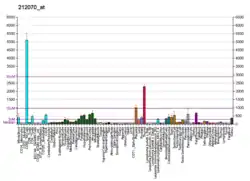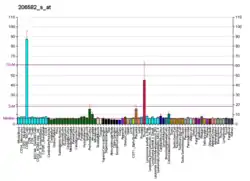G protein-coupled receptor 56 also known as TM7XN1 is a protein encoded by the ADGRG1 gene.[5] GPR56 is a member of the adhesion GPCR family.[6][7] Adhesion GPCRs are characterized by an extended extracellular region often possessing N-terminal protein modules that is linked to a TM7 region via a domain known as the GPCR-Autoproteolysis INducing (GAIN) domain.[8]
GPR56 is expressed in liver, muscle, tendon, neural, and cytotoxic lymphoid cells in human as well as in hematopoietic precursor, muscle, and developing neural cells in the mouse.[9] GPR56 has been shown to have numerous role in cell guidance/adhesion as exemplified by its roles in tumour inhibition and neuron development.[10][11] More recently it has been shown to be a marker for cytotoxic T cells and a subgroup of Natural killer cells.[12]
Ligands
GPR56 binds transglutaminase 2 to suppress tumor metastasis[13] and binds collagen III to regulate cortical development and lamination.[14]
Signaling
GPR56 couples to Gαq/11 protein upon association with the tetraspanins CD9 and CD81.[15] Forced GPR56 expression activates NF-kB, PAI-1, and TCF transcriptional response elements.[16] The splicing of GPR56 induces tumorigenic responses as a result of activating the transcription of genes, such as COX2, iNOS, and VEGF85. GPR56 couples to the Gα12/13 protein and activates RhoA and mammalian target of rapamycin (mTOR) pathway upon ligand binding.[14][17][18][19] Lack of the N-terminal fragment (NTF) of GPR56 causes stronger RhoA signaling and β-arrestin accumulation, leading to extensive ubiquitination of the C-terminal fragment (CTF).[20] Finally, GPR56 suppresses PKCα activation to regulate angiogenesis.[21]
Function
Studies in the hematopoietic system disclosed that during endothelial to hematopoietic stem cell transition, Gpr56 is a transcriptional target of the heptad complex of hematopoietic transcription factors, and is required for hematopoietic cluster formation.[22] Recently, two studies showed that GPR56, is a cell autonomous regulator of oligodendrocyte development through Gα12/13 proteins and Rho activation.[18][23] Della Chiesa et al. demonstrate that GPR56 is expressed on CD56dull natural killer (NK) cells.[24] Lin and Hamann's group show all human cytotoxic lymphocytes, including CD56dull NK cells and CD27–CD45RA+ effector-type CD8+ T cells, express GPR56.[12]
Clinical significance
GPR56 was the first adhesion GPCR causally linked to a disease. Loss-of-function mutations in GPR56 cause a severe cortical malformation known as bilateral frontoparietal polymicrogyria (BFPP).[25][26][27][28][29][30][31] Investigating the pathological mechanism of disease-associated GPR56 mutations in BFPP has provided mechanistic insights into the functioning of adhesion GPCRs. Researchers demonstrated that disease-associated GPR56 mutations cause BFPP via multiple mechanisms.[32][33][34][35] Li et al. demonstrated that GPR56 regulates pial basement membrane (BM) organization during cortical development. Disruption of the Gpr56 gene in mice leads to neuronal malformation in the cerebral cortex, which resulted in 4 critical pathological morphologies: defective pial BM, abnormal localized radial glial endfeet, malpositioned Cajal-Retzius cells, and overmigrated neurons.[36] Furthermore, the interaction of GPR56 and collagen III inhibits neural migration to regulate lamination of the cerebral cortex.[14] Next to GPR56, the α3β1 integrin is also involved in pial BM maintenance. Study from Itga3 (α3 integrin)/Gpr56 double knockout mice showed increased neuronal overmigration compared to Gpr56 single knockout mice, indicating cooperation of GPR56 and α3β1 integrin in modulation of the development of the cerebral cortex.[37] More recently, the Walsh laboratory showed that alternative splicing of GPR56 regulates regional cerebral cortical patterning.[38]
In depression patients, blood GPR56 mRNA expression increases only in responders and not non-responders to serotonin-norepinephrine reuptake inhibitor treatment.[39] Furthermore, GPR56 was down-regulated in the prefrontal cortex of individuals with depression that died by suicide.
Outside the nervous system, GPR56 has been linked to muscle function and male fertility. The expression of GPR56 is upregulated during early differentiation of human myoblasts. Investigation of Gpr56 knockout mice and BFPP patients showed that GPR56 is required for in vitro myoblast fusion via signaling of serum response factor (SRF) and nuclear factor of activated T-cell (NFAT), but is not essential for muscle development in vivo.[40] Additionally, GPR56 is a transcriptional target of peroxisome proliferator-activated receptor gamma coactivator 1-alpha 4 and regulates overload-induced muscle hypertrophy through Gα12/13 and mTOR signaling.[19] Therefore, the study of knockout mice revealed that GPR56 is involved in testis development and male fertility.[41] In melanocytic cells GPR56 gene expression may be regulated by MITF.[42]
Mutations in GPR56 cause the brain developmental disorder BFPP, characterized by disordered cortical lamination in frontal cortex.[25] Mice lacking expression of GPR56 develop a comparable phenotype.[36] Furthermore, loss of GPR56 leads to reduced fertility in male mice, resulting from a defect in seminiferous tubule development.[41] GPR56 is expressed in glioblastoma/astrocytoma[16] as well as in esophageal squamous cell,[43] breast, colon, non-small cell lung, ovarian, and pancreatic carcinoma.[44] GPR56 was shown to localize together with α-actinin at the leading edge of membrane filopodia in glioblastoma cells, suggesting a role in cell adhesion/migration.[16] In addition, recombinant GPR56-NTF protein interacts with glioma cells to inhibit cellular adhesion. Inactivation of Von Hippel-Lindau (VHL) tumor-suppressor gene and hypoxia suppressed GPR56 in a renal cell carcinoma cell line, but hypoxia influenced GPR56 expression in breast or bladder cancer cell lines.[45] GPR56 is a target gene for vezatin, an adherens junctions transmembrane protein, which is a tumor suppressor in gastric cancer.[46] Xu et al. used an in vivo metastatic model of human melanoma to show that GPR56 is downregulated in highly metastatic cells.[13] Later, by ectopic expression and RNA interference they confirmed that GPR56 inhibits melanoma tumor growth and metastasis. Silenced expression of GPR56 in HeLa cells enhanced apoptosis and anoikis, but suppressed anchorage-independent growth and cell adhesion.[44] High ecotropic viral integration site-1 acute myeloid leukemia (EVI1-high AML) expresses GPR56 that was found to be a transcriptional target of EVI1.[47] Silencing expression of GPR56 decreases adhesion, cell growth and induces apoptosis through reduced RhoA signaling. GPR56 suppresses the angiogenesis and melanoma growth through inhibition of vascular endothelial growth factor (VEGF) via PKCα signaling pathway.[21] Furthermore, GPR56 expression was found to be negatively correlated with the malignancy of melanomas in human patients.
References
- 1 2 3 GRCh38: Ensembl release 89: ENSG00000205336 - Ensembl, May 2017
- 1 2 3 GRCm38: Ensembl release 89: ENSMUSG00000031785 - Ensembl, May 2017
- ↑ "Human PubMed Reference:". National Center for Biotechnology Information, U.S. National Library of Medicine.
- ↑ "Mouse PubMed Reference:". National Center for Biotechnology Information, U.S. National Library of Medicine.
- ↑ Hamann J, Aust G, Araç D, Engel FB, Formstone C, Fredriksson R, et al. (April 2015). "International Union of Basic and Clinical Pharmacology. XCIV. Adhesion G protein-coupled receptors". Pharmacological Reviews. 67 (2): 338–67. doi:10.1124/pr.114.009647. PMC 4394687. PMID 25713288.
- ↑ Stacey M, Yona S (2011). Adhesion-GPCRs: Structure to Function (Advances in Experimental Medicine and Biology). Berlin: Springer. ISBN 978-1-4419-7912-4.
- ↑ Langenhan T, Aust G, Hamann J (May 2013). "Sticky signaling--adhesion class G protein-coupled receptors take the stage". Science Signaling. 6 (276): re3. doi:10.1126/scisignal.2003825. PMID 23695165. S2CID 6958640.
- ↑ Araç D, Boucard AA, Bolliger MF, Nguyen J, Soltis SM, Südhof TC, Brunger AT (March 2012). "A novel evolutionarily conserved domain of cell-adhesion GPCRs mediates autoproteolysis". The EMBO Journal. 31 (6): 1364–78. doi:10.1038/emboj.2012.26. PMC 3321182. PMID 22333914.
- ↑ Hamann J, Aust G, Araç D, Engel FB, Formstone C, Fredriksson R, et al. (Apr 2015). "International Union of Basic and Clinical Pharmacology. XCIV. Adhesion G protein-coupled receptors". Pharmacological Reviews. 67 (2): 338–67. doi:10.1124/pr.114.009647. PMC 4394687. PMID 25713288.
- ↑ Xu L (2010). "GPR56 Interacts with Extracellular Matrix and Regulates Cancer Progression". Adhesion-GPCRS. Advances in Experimental Medicine and Biology. Vol. 706. pp. 98–108. doi:10.1007/978-1-4419-7913-1_8. ISBN 978-1-4419-7912-4. PMID 21618829.
- ↑ Strokes N, Piao X (2010). "Adhesion-GPCRS in the CNS". Adhesion-GPCRS. Advances in Experimental Medicine and Biology. Vol. 706. pp. 87–97. doi:10.1007/978-1-4419-7913-1_7. ISBN 978-1-4419-7912-4. PMID 21618828.
- 1 2 Peng YM, van de Garde MD, Cheng KF, Baars PA, Remmerswaal EB, van Lier RA, et al. (October 2011). "Specific expression of GPR56 by human cytotoxic lymphocytes". Journal of Leukocyte Biology. 90 (4): 735–40. doi:10.1189/jlb.0211092. PMID 21724806. S2CID 2885203.
- 1 2 Xu L, Begum S, Hearn JD, Hynes RO (June 2006). "GPR56, an atypical G protein-coupled receptor, binds tissue transglutaminase, TG2, and inhibits melanoma tumor growth and metastasis". Proceedings of the National Academy of Sciences of the United States of America. 103 (24): 9023–8. Bibcode:2006PNAS..103.9023X. doi:10.1073/pnas.0602681103. PMC 1474142. PMID 16757564.
- 1 2 3 Luo R, Jeong SJ, Jin Z, Strokes N, Li S, Piao X (August 2011). "G protein-coupled receptor 56 and collagen III, a receptor-ligand pair, regulates cortical development and lamination". Proceedings of the National Academy of Sciences of the United States of America. 108 (31): 12925–30. Bibcode:2011PNAS..10812925L. doi:10.1073/pnas.1104821108. PMC 3150909. PMID 21768377.
- ↑ Little KD, Hemler ME, Stipp CS (May 2004). "Dynamic regulation of a GPCR-tetraspanin-G protein complex on intact cells: central role of CD81 in facilitating GPR56-Galpha q/11 association". Molecular Biology of the Cell. 15 (5): 2375–87. doi:10.1091/mbc.E03-12-0886. PMC 404030. PMID 15004227.
- 1 2 3 Shashidhar S, Lorente G, Nagavarapu U, Nelson A, Kuo J, Cummins J, et al. (March 2005). "GPR56 is a GPCR that is overexpressed in gliomas and functions in tumor cell adhesion". Oncogene. 24 (10): 1673–82. doi:10.1038/sj.onc.1208395. PMID 15674329.
- ↑ Iguchi T, Sakata K, Yoshizaki K, Tago K, Mizuno N, Itoh H (May 2008). "Orphan G protein-coupled receptor GPR56 regulates neural progenitor cell migration via a G alpha 12/13 and Rho pathway". The Journal of Biological Chemistry. 283 (21): 14469–78. doi:10.1074/jbc.M708919200. PMID 18378689.
- 1 2 Ackerman SD, Garcia C, Piao X, Gutmann DH, Monk KR (January 2015). "The adhesion GPCR Gpr56 regulates oligodendrocyte development via interactions with Gα12/13 and RhoA". Nature Communications. 6: 6122. Bibcode:2015NatCo...6.6122A. doi:10.1038/ncomms7122. PMC 4302765. PMID 25607772.
- 1 2 White JP, Wrann CD, Rao RR, Nair SK, Jedrychowski MP, You JS, et al. (November 2014). "G protein-coupled receptor 56 regulates mechanical overload-induced muscle hypertrophy". Proceedings of the National Academy of Sciences of the United States of America. 111 (44): 15756–61. Bibcode:2014PNAS..11115756W. doi:10.1073/pnas.1417898111. PMC 4226111. PMID 25336758.
- ↑ Paavola KJ, Stephenson JR, Ritter SL, Alter SP, Hall RA (August 2011). "The N terminus of the adhesion G protein-coupled receptor GPR56 controls receptor signaling activity". The Journal of Biological Chemistry. 286 (33): 28914–21. doi:10.1074/jbc.M111.247973. PMC 3190698. PMID 21708946.
- 1 2 Yang L, Chen G, Mohanty S, Scott G, Fazal F, Rahman A, et al. (August 2011). "GPR56 Regulates VEGF production and angiogenesis during melanoma progression". Cancer Research. 71 (16): 5558–68. doi:10.1158/0008-5472.CAN-10-4543. PMC 3156271. PMID 21724588.
- ↑ Solaimani Kartalaei P, Yamada-Inagawa T, Vink CS, de Pater E, van der Linden R, Marks-Bluth J, et al. (January 2015). "Whole-transcriptome analysis of endothelial to hematopoietic stem cell transition reveals a requirement for Gpr56 in HSC generation". The Journal of Experimental Medicine. 212 (1): 93–106. doi:10.1084/jem.20140767. PMC 4291529. PMID 25547674.
- ↑ Giera S, Deng Y, Luo R, Ackerman SD, Mogha A, Monk KR, et al. (January 2015). "The adhesion G protein-coupled receptor GPR56 is a cell-autonomous regulator of oligodendrocyte development". Nature Communications. 6: 6121. Bibcode:2015NatCo...6.6121G. doi:10.1038/ncomms7121. PMC 4302951. PMID 25607655.
- ↑ Della Chiesa M, Falco M, Parolini S, Bellora F, Petretto A, Romeo E, et al. (February 2010). "GPR56 as a novel marker identifying the CD56dull CD16+ NK cell subset both in blood stream and in inflamed peripheral tissues". International Immunology. 22 (2): 91–100. doi:10.1093/intimm/dxp116. PMID 20008459.
- 1 2 Piao X, Hill RS, Bodell A, Chang BS, Basel-Vanagaite L, Straussberg R, et al. (March 2004). "G protein-coupled receptor-dependent development of human frontal cortex". Science. 303 (5666): 2033–6. Bibcode:2004Sci...303.2033P. CiteSeerX 10.1.1.658.1106. doi:10.1126/science.1092780. PMID 15044805. S2CID 8419753.
- ↑ Piao X, Chang BS, Bodell A, Woods K, Benzeev B, Topcu M, et al. (November 2005). "Genotype-phenotype analysis of human frontoparietal polymicrogyria syndromes". Annals of Neurology. 58 (5): 680–7. CiteSeerX 10.1.1.490.3697. doi:10.1002/ana.20616. PMID 16240336. S2CID 16984116.
- ↑ Parrini E, Ferrari AR, Dorn T, Walsh CA, Guerrini R (June 2009). "Bilateral frontoparietal polymicrogyria, Lennox-Gastaut syndrome, and GPR56 gene mutations". Epilepsia. 50 (6): 1344–53. doi:10.1111/j.1528-1167.2008.01787.x. PMC 4271835. PMID 19016831.
- ↑ Bahi-Buisson N, Poirier K, Boddaert N, Fallet-Bianco C, Specchio N, Bertini E, et al. (November 2010). "GPR56-related bilateral frontoparietal polymicrogyria: further evidence for an overlap with the cobblestone complex". Brain. 133 (11): 3194–209. doi:10.1093/brain/awq259. PMID 20929962.
- ↑ Luo R, Yang HM, Jin Z, Halley DJ, Chang BS, MacPherson L, et al. (July 2011). "A novel GPR56 mutation causes bilateral frontoparietal polymicrogyria". Pediatric Neurology. 45 (1): 49–53. doi:10.1016/j.pediatrneurol.2011.02.004. PMC 3135102. PMID 21723461.
- ↑ Quattrocchi CC, Zanni G, Napolitano A, Longo D, Cordelli DM, Barresi S, et al. (February 2013). "Conventional magnetic resonance imaging and diffusion tensor imaging studies in children with novel GPR56 mutations: further delineation of a cobblestone-like phenotype". Neurogenetics. 14 (1): 77–83. doi:10.1007/s10048-012-0352-7. PMID 23274687. S2CID 18696428.
- ↑ Santos-Silva R, Passas A, Rocha C, Figueiredo R, Mendes-Ribeiro J, Fernandes S, et al. (April 2015). "Bilateral frontoparietal polymicrogyria: a novel GPR56 mutation and an unusual phenotype". Neuropediatrics. 46 (2): 134–8. doi:10.1055/s-0034-1399754. PMID 25642806. S2CID 10890042.
- ↑ Jin Z, Tietjen I, Bu L, Liu-Yesucevitz L, Gaur SK, Walsh CA, Piao X (August 2007). "Disease-associated mutations affect GPR56 protein trafficking and cell surface expression". Human Molecular Genetics. 16 (16): 1972–85. doi:10.1093/hmg/ddm144. PMID 17576745.
- ↑ Ke N, Ma H, Diedrich G, Chionis J, Liu G, Yu DH, et al. (February 2008). "Biochemical characterization of genetic mutations of GPR56 in patients with bilateral frontoparietal polymicrogyria (BFPP)". Biochemical and Biophysical Research Communications. 366 (2): 314–20. doi:10.1016/j.bbrc.2007.11.071. PMID 18042463.
- ↑ Chiang NY, Hsiao CC, Huang YS, Chen HY, Hsieh IJ, Chang GW, Lin HH (April 2011). "Disease-associated GPR56 mutations cause bilateral frontoparietal polymicrogyria via multiple mechanisms". The Journal of Biological Chemistry. 286 (16): 14215–25. doi:10.1074/jbc.M110.183830. PMC 3077623. PMID 21349848.
- ↑ Luo R, Jin Z, Deng Y, Strokes N, Piao X (2012). "Disease-associated mutations prevent GPR56-collagen III interaction". PLOS ONE. 7 (1): e29818. Bibcode:2012PLoSO...729818L. doi:10.1371/journal.pone.0029818. PMC 3251603. PMID 22238662.
- 1 2 Li S, Jin Z, Koirala S, Bu L, Xu L, Hynes RO, et al. (May 2008). "GPR56 regulates pial basement membrane integrity and cortical lamination". The Journal of Neuroscience. 28 (22): 5817–26. doi:10.1523/JNEUROSCI.0853-08.2008. PMC 2504715. PMID 18509043.
- ↑ Jeong SJ, Luo R, Singer K, Giera S, Kreidberg J, Kiyozumi D, et al. (2013). "GPR56 functions together with α3β1 integrin in regulating cerebral cortical development". PLOS ONE. 8 (7): e68781. Bibcode:2013PLoSO...868781J. doi:10.1371/journal.pone.0068781. PMC 3706371. PMID 23874761.
- ↑ Bae BI, Tietjen I, Atabay KD, Evrony GD, Johnson MB, Asare E, et al. (February 2014). "Evolutionarily dynamic alternative splicing of GPR56 regulates regional cerebral cortical patterning". Science. 343 (6172): 764–8. Bibcode:2014Sci...343..764B. doi:10.1126/science.1244392. PMC 4480613. PMID 24531968.
- ↑ Belzeaux R, Gorgievski V, Fiori LM, Lopez JP, Grenier J, Lin R, et al. (April 2020). "GPR56/ADGRG1 is associated with response to antidepressant treatment". Nature Communications. 11 (1): 1635. Bibcode:2020NatCo..11.1635B. doi:10.1038/s41467-020-15423-5. PMC 7118175. PMID 32242018.
- ↑ Wu MP, Doyle JR, Barry B, Beauvais A, Rozkalne A, Piao X, et al. (December 2013). "G-protein coupled receptor 56 promotes myoblast fusion through serum response factor- and nuclear factor of activated T-cell-mediated signalling but is not essential for muscle development in vivo". The FEBS Journal. 280 (23): 6097–113. doi:10.1111/febs.12529. PMC 3877849. PMID 24102982.
- 1 2 Chen G, Yang L, Begum S, Xu L (December 2010). "GPR56 is essential for testis development and male fertility in mice". Developmental Dynamics. 239 (12): 3358–67. doi:10.1002/dvdy.22468. PMC 2991479. PMID 20981830.
- ↑ Hoek KS, Schlegel NC, Eichhoff OM, Widmer DS, Praetorius C, Einarsson SO, et al. (December 2008). "Novel MITF targets identified using a two-step DNA microarray strategy". Pigment Cell & Melanoma Research. 21 (6): 665–76. doi:10.1111/j.1755-148X.2008.00505.x. PMID 19067971. S2CID 24698373.
- ↑ Sud N, Sharma R, Ray R, Chattopadhyay TK, Ralhan R (February 2006). "Differential expression of G-protein coupled receptor 56 in human esophageal squamous cell carcinoma". Cancer Letters. 233 (2): 265–70. doi:10.1016/j.canlet.2005.03.018. PMID 15916848.
- 1 2 Ke N, Sundaram R, Liu G, Chionis J, Fan W, Rogers C, et al. (June 2007). "Orphan G protein-coupled receptor GPR56 plays a role in cell transformation and tumorigenesis involving the cell adhesion pathway". Molecular Cancer Therapeutics. 6 (6): 1840–50. doi:10.1158/1535-7163.MCT-07-0066. PMID 17575113.
- ↑ Maina EN, Morris MR, Zatyka M, Raval RR, Banks RE, Richards FM, et al. (June 2005). "Identification of novel VHL target genes and relationship to hypoxic response pathways". Oncogene. 24 (28): 4549–58. doi:10.1038/sj.onc.1208649. PMID 15824735.
- ↑ Miao R, Guo X, Zhi Q, Shi Y, Li L, Mao X, et al. (2013). "VEZT, a novel putative tumor suppressor, suppresses the growth and tumorigenicity of gastric cancer". PLOS ONE. 8 (9): e74409. Bibcode:2013PLoSO...874409M. doi:10.1371/journal.pone.0074409. PMC 3775783. PMID 24069310.
- ↑ Saito Y, Kaneda K, Suekane A, Ichihara E, Nakahata S, Yamakawa N, et al. (August 2013). "Maintenance of the hematopoietic stem cell pool in bone marrow niches by EVI1-regulated GPR56". Leukemia. 27 (8): 1637–49. doi:10.1038/leu.2013.75. PMID 23478665.





